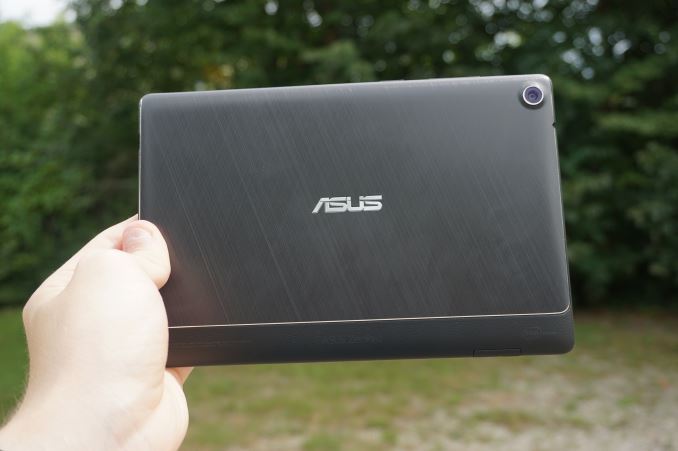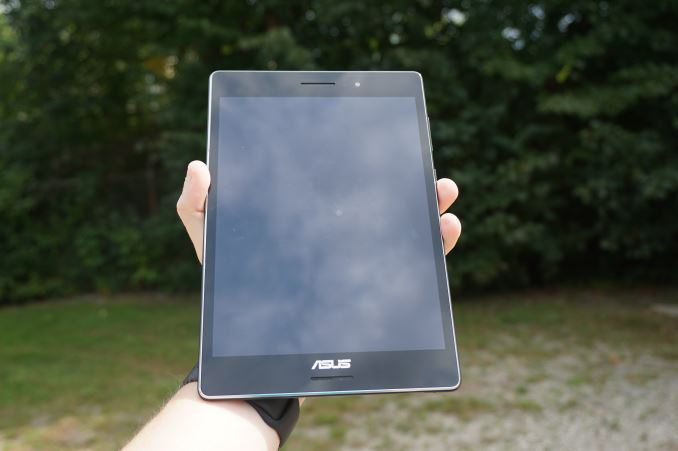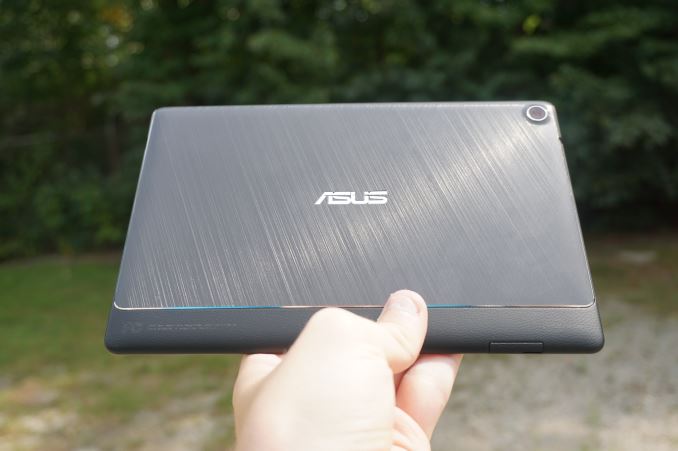The ASUS ZenPad S (Z580CA) Review
by Brandon Chester on August 31, 2015 8:00 AM ESTFinal Words
As I said in the introduction, its been a long time since we've seen a tablet from ASUS that wasn't aimed at the low end of the market. The ZenPad S Z580CA isn't a $500 flagship tablet, but with the specifications it provides it's essentially a high end 8" Android tablet. Like the ZenFone 2, its $299 price would have you believe that its specifications are less impressive than they really are. However, it's really impossible to judge a device solely based on how it looks on paper, even when what you seen on a spec sheet looks appealing. Over the course of reviewing the ZenPad S I've encountered aspects of it that are good, and some that need improvement. I suppose this is the best time to go over everything once more before making some conclusions.
The ZenPad S does a good job of making a plastic chassis feel solid and high quality. The hard plastic on the back does a better job of emulating the feeling of metal than any other device I've used before. I personally would have not opted to make the sides and part of the back cover out of a soft touch plastic, because it introduces seams and breaks in the chassis which is detrimental to the design. I also feel a bit spoiled by the fact that there are devices like the iPad Mini 2 which give you a fully aluminum chassis for $299 as well. The ZenPad ends up being thinner and much lighter than the iPad, which is certainly a benefit for any user who wants a device that they can bring everywhere without feeling like they're lugging around a heavy object. My personal use case for a tablet leads me to lean toward a thicker and heavier aluminum chassis over a thinner and lighter plastic one, but I recognize that other people may have different needs which make the ZenPad S a more appealing device in that regard.
One area where an aluminum chassis would certainly help is durability. While metal can obviously dent and scratch, my time with the ZenPad S has made it clear that there are both issues with the durability of the plastic used, and with the tolerances for defects in the materials. If I was purchasing the ZenPad S for myself I would definitely not consider the deformed edges of the hard plastic that my review unit has to be acceptable, and the same would go for the easily damaged edge around the bezel. Even without a metal chassis, other plastic tablets like the Dell Venue 10 and the Nexus 9 have held up much better over the course of weeks and months than the ZenPad S did in only a week. Durability is definitely something to keep in mind if you're fairly rough on your devices, or if you want to keep your ZenPad for a long period of time.
As far as performance goes, the ZenPad S is right in line with all the other Intel devices that I've looked at. The 4GB of RAM means that you will rarely ever see a process be evicted from memory, but with Android having no support for split screen application views it almost feels like the ZenPad S has some untapped potential. The CPU performance is just as good if not better than anything else you'll find at this price, and the 533MHz G6430 GPU ends up being slightly faster than the implementation in Apple's A7 SoC. In my reviews of Dell's Venue tablets I remarked that Atom Z3580 didn't feel competitive enough in a $400 or $500 device, but in a $300 tablet it feels right at home.
The ZenPad's display is difficult to come to a conclusion on. Out of the box the image rendition is very inaccurate, but you can make significant improvements by adjusting the color temperature. My problem with this is that I think it's wrong to offer bad default settings that the user has to fix on their own, especially when there's no way they can find the optimal setting for a display by using their eye alone. Even after adjusting the display, the overall accuracy is still significantly lower than the iPad Mini 2 despite the ZenPad S not suffering from the narrow gamut that the iPad does.
On top of the issues with color accuracy, ASUS's True2Life+ tweaks have a very negative impact on display quality. The over-sharpening causes halos around text, and when text is a small size it actually makes it more difficult to read than it would be if it hadn't been artificially sharpened, which is contrary to the entire point of sharpening. ASUS's CABC also goes way overboard, to the point where you can notice the brightness of the display constantly shifting as you scroll around and move between apps. Without True2Life+ I would still lean toward the iPad Mini 2 having a better display due to its greater accuracy with common color mixtures, even if it does have a narrow gamut and isn't laminated. Despite that, I would have said that the ZenPad S's display is still very good for a $299 device. Unfortunately, the post processing that ASUS performs really degrades image quality to the point where the ZenPad's display is not something I can highly praise.
There's not much to say about the camera quality of the ZenPad S. It suffers from all the same issues as the ZenFone 2, and I really wouldn't use it to take photos unless there's no alternative. Thankfully I don't think that the camera is a huge selling point for a $300 tablet, and so this problem isn't that serious.
Battery life on the ZenPad S was good considering the battery capacity it's working with, but not competitive with other tablets. With tablets there's really no room to have your battery life fall short, because there's been an expectation of ten hours of battery life from tablets for over five years now. In every battery category the ZenPad either doesn't last as long as competing tablets, or lasts as long or longer but with the caveat that performance over that period of time wasn't as high as the competition. I think a larger battery would have really been beneficial, even if it meant that the ZenPad S Z580CA had to be heavier and 7mm or 7.5mm thick instead of 6.6mm.
In the end I'm not as impressed by the ZenPad S Z580CA as I was with the ZenFone 2. In the case of the ZenFone 2 I actually felt that the $199 model offered the best value because you were only trading away some NAND, dropping to 2GB of RAM, and limiting the CPU clock to 1.8GHz instead of 2.33GHz. If the ZenPad S Z580C was the same sort of downgrade I would have no trouble recommending it for $199. However, you end up with significant reductions to both the CPU and GPU clocks, worse cameras, halved RAM and NAND, no 802.11ac WiFi (assuming it gets fixed on the Z580CA), and no USB Type-C connector. That's a lot of sacrifices to save $100, and the performance impact of dropping the max CPU clock to 1.33GHz would be very significant in bursty workloads.
As for the Z580CA itself, there are just a lot of issues that are difficult to overlook. The build quality and construction is just not competitive with the iPad Mini 2 or the more expensive but still relevant Dell Venue 8 7840. Much of the other issues are rooted in software, like the WiFi issue, the display issues, the camera issues, and before a recent software update, the video playback issues. While I didn't talk about ZenUI in this review, anyone who visited the link to my discussion of it in my ZenFone 2 review knows that you'll also be dealing with a large number of pre-installed apps on the ZenPad S, with most of them not being very useful. There's also still the fact that the library of really good tablet apps for Android devices is still quite small, and while this isn't within ASUS's control, it's still a very real issue to consider when you have the iPad Mini 2 competing at the exact same price.
At $299, the ZenPad S Z580CA actually doesn't have much in the way of direct competition from other Android OEMs. The $399 price point seems to be where a lot of manufacturers have aimed, with devices like the Dell Venue 8, Nexus 9, and Galaxy Tab S2 8.0 all selling for that price. With that in mind, the ZenPad S does end up being the best device at its price point, but due to a lack of competition more than anything else. If I were recommending a tablet to someone aiming to spend around $299 I would still lean toward the iPad Mini 2 if they weren't partial to Android or iOS. If someone does really need a tablet that runs Android for any number of reasons then I think it would be best to save up and take a look at the devices selling for around $400. That being said, if a user can't use a tablet that runs iOS and can't budge from a $300 price, then the ZenPad S Z580CA appears to be the best of the few options available.













114 Comments
View All Comments
kmmatney - Monday, August 31, 2015 - link
Having both a 16:9 windows tablet and an iPad, IMO 4:3 is better. Who plays "immersive" games on there tablet? - that's what a computer or laptop is for. For typical things you use a tablet for - web browsing, reading emails, reading books, you tube, various other consumption, the 4:3 aspect ratio is perfect. I don't pretend to do any serious work on my tablets, but I wish my windows tablet was 4:3. There is a reason why the MS Surface tablets no longer use a 16:9 aspect ratio.boeush - Monday, August 31, 2015 - link
This is getting pretty stupid... Let's say your tablet is x inches long. Does it really make that much difference whether it's height gives 19:10 ot 4:3 AR? Unlike a phone, you aren't about to shove that tablet into a pocket. So is it REALLY so TERRIBLE that you have extra vertical screen space when watching a movie in landscape? Yeah, instead of that extra screen you could just have empty space I guess - but that still won't make your tablet all that more compact anyway (with the horizontal dimension being dominant.) So boo-hoo, you get top and bottom sidebars on your video. Contrast that with the use cases where you need/want that extra height in your landscape mode, or the extra width in portrait - and DON'T HAVE IT because your tablet is built oblong and that's that. Seriously, I for one would rather have extra screen space I don't need under certain circumstances, rather than at other times needing the extra space and not having it!keltypack - Monday, August 31, 2015 - link
I totally agree with the 4:3 aspect ratio. I don't know what people are thinking, but a tablet is a GREAT way to watch a movie on an airplane. The 16:9 ratio is much better for reading books. I don't understand the Apple fascination with 4:3. To be fair, I think 3:2 is a better aspect ratio than 16:9, but maybe that is the old-school photographer in me.uhuznaa - Monday, August 31, 2015 - link
16:9 sucks for websites and more compley apps though, both in portrait (too narrow) and in landscape (with some toolbars around you see only a small sliver and when typing into a form there's hardly any content left).But yes, if you're mainly watching movies with your tablet, 16:9 is better.
sonny73n - Tuesday, September 1, 2015 - link
The only reason 16:9 is better for movies because all HD contents are in 16:9. But to me, 16:9 is just odd and stupid. I remember when the first wave of HDTV hit the market, there was a widescreen trend. So bad they even started making movies wider than 16:9 - something really odd like 1920x818 instead of the 1920x1080.16:9 is horrible even on phones. Keyboard in landscape mode blocks more than 50% of the screen. You can have a 4.7in 1280x768 screen looks as big as a 5in 1280x720. 16:9 sucks, movies too. I'd rather see movies in 2:3 format.
BurntMyBacon - Wednesday, September 2, 2015 - link
@sonny73n: 16:10 more accurately maps to the active area of the human visual system and thus gives a more immersive experience at the appropriate screen size / viewing distance. 16:9 was just cost cutting measure by reducing the probability of defects in a screen given the statistical probability of localization. Problem is, you can't interact with your tablet when it's in your face. Most people don't sit that close to a TV either. Usability on 16:9 isn't very good. It is better at 16:10, but 4:3 or 3:2 can make more sense in a lot of cases. I personally prefer 16:10 (1280x800 in your example above), but a lot of that depends on how the tools you use are laid out.R. Hunt - Tuesday, September 1, 2015 - link
Apps look so much more natural in 4:3 IMO. Web browsing, and PDF reading are also better. I think, specially for large tablets, a squarer aspect ratio is overall the better choice. My Tab Pro 10.1 looks and feels really awkward in portrait (and unnecessarily long). I'll be getting the Tab S2 soon, no doubt.BurntMyBacon - Wednesday, September 2, 2015 - link
@keltypack: Yes. Your 3:2 preference is the old school photographer in you. Nothin wrong with that.retrospooty - Monday, August 31, 2015 - link
jjj, I think you need to put the pipe down.Puck85 - Thursday, September 10, 2015 - link
serious question: what should I buy instead of this around this price range?